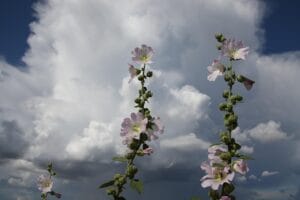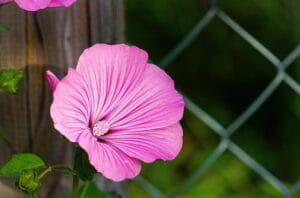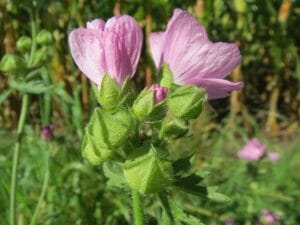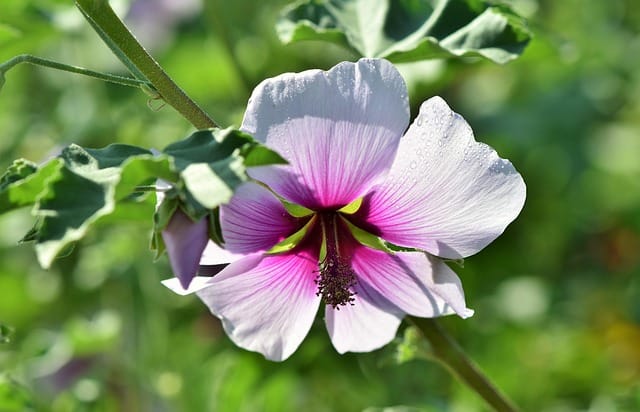Introduction
A tall perennial, marsh mallow is prized for its hibiscus-like blooms. Mucilage, which is found in the plant’s roots and leaves, solidifies into a thick gel when combined with water. The ancient Egyptians invented the confection that is now known as marshmallows (which no longer contain any trace of the plant) and used marshmallows for medicinal purposes. Pollinators adore the flowers. Late September sees the formation of brown seed pods, which mature to release tiny black seeds.
Marsh mallow is sown from seed in the fall or spring, depending on your climate.

Feature | Details |
Common Name | |
Scientific Name | |
Plant Type | Perennial herb |
Family | Malvaceae |
Native Region | Europe, Western Asia, North Africa |
Height | 3–4 feet (0.9–1.2 meters) |
Soil Requirement | Moist, well-draining, rich in organic matter |
Sunlight | Full sun to partial shade |
Watering | Regular, prefers consistently moist soil |
Flower Color | Pale pink to white |
Blooming Season | Summer (June to August) |
Uses | Medicinal (soothing cough, digestive aid), culinary (herbal teas, confectionery) |
USDA Hardiness Zones | 3–9 |
Propagation | Seeds, root division |
Special Notes | Roots contain mucilage, historically used to make marshmallow candy |
Marsh Mallow Plant Care
The plant is a great choice for damp, marshy environments and is very easy to maintain. The following are the primary requirements for maintaining a marsh mallow plant:
Place marsh mallow in a spot that receives full sun and has moist or wet soil that drains well.
Maintain a constant moisture content in the soil and water it appropriately.
Till the plants are tall and well-established, keep the area free of weeds and cover the plants with a 2-inch layer of mulch.
Marsh mallow doesn’t require fertilization.
During the growing season, remove any dead leaves and deadhead spent flowers.

Soil
The marsh mallow plant, as its name suggests, prefers moist, marshy environments. The ideal location is one with continuously moist soil that has a pH of about 6.0, which is slightly acidic. However, these plants are not sensitive to soil pH, so don’t worry too much about creating acidic soil conditions.
Water
Marsh mallow plants require regular moisture and adequate drainage. Add soil amendments that retain moisture, like organic matter, if your soil is sandy. Conversely, standing water is too moist for the plants.

Light
Marsh mallow plants do not thrive in partial shade; they require full sun. Take care not to plant them where they will be shaded by taller plants.
Temperature and Humidity
Marsh mallows are hardy plants that can withstand a wide range of temperatures and humidity levels. Although they will die back in subfreezing temperatures and reappear in the spring, they are incredibly cold-tolerant. They don’t have any preferences or dislikes regarding humidity.
Fertilizer
Applying a specific type of fertilizer isn’t really necessary for marsh mallow plants because they can grow in a wide variety of soil types, including soil with a high saline content. This is especially true if you have already added organic matter to the soil.
Propagating
Dig up the entire root system of the plant. Using a sharp spade, cut the root mass into smaller pieces. Replant the sections at the same depth as the original plant in a new, suitable location.
Although it may be challenging to find the plants before they break their winter dormancy, division propagation can also be done in the early spring before the leaves have started to appear.

Pruning
Although pruning marsh mallow plants is not strictly required, it does enhance the plant’s appearance by removing any dead leaves and deadheading spent flowers. Additionally, this deters pests from visiting the plant.
Common Pests & Diseases
Even though almost every part of the marsh mallow plant is edible, pests tend to ignore it. However, flea beetles, which lay their eggs close to the roots of your marsh mallows, are one invader that might choose to eat them. The larvae leave behind pinprick-sized holes after feeding on the roots and then the leaves. Use neem oil if the issue occurs. Officinalis althaea. Botanical Garden of Missouri.

Except for rust, a fungal disease that manifests as elevated white dots on the underside of leaves, marsh mallows are remarkably resistant to disease. One Eventually, the afflicted areas turn orange, then yellowish-green, and then black. Remove any impacted leaves and refrain from watering from above if you observe this condition. Use a rust-treating fungicide with a copper base in extreme situations.
FAQ
What is marsh mallow used for?
Marshmallow (Althea officinalis) is a plant. The leaves and the root are sometimes used to make medicine. Marshmallow is sometimes used to form a protective layer on the skin and lining of the digestive tract. It also contains chemicals that might decrease cough and fight infections.
Is the marsh mallow plant edible?
The roots, leaves, and flowers are edible. Mucilages found in marsh mallow roots and leaves are used and typically prepared as a tea to treat throat problems. They relieve pain and inhibit inflammation in mucous membranes.
What are the side effects of mallow?
When taken by mouth: Mallow flower extract is possibly safe when used for up to 4 weeks. It might cause stomach problems such as nausea, diarrhea, and indigestion in some people. Pregnancy and breastfeeding: There isn’t enough reliable information to know if mallow is safe to use when pregnant or breastfeeding.
Can I eat mallow leaves?
The leaves can be cooked and eaten like spinach, added to thicken soups or deep-fried like green wafers.
How to use a marshmallow plant?
You can use the tea in oatmeal or even in soup to help thicken it a bit and add the beneficial soothing qualities. You can make a poultice for minor wounds, insect bites, and rashes by making a tea and then soaking a cloth in the tea and applying it to the area. Marshmallow root is also where marshmallows come from!
How to identify a marshmallow plant?
Common mallow freely branches at the base, with a prostrate growth habit. It is a low-growing weed with a deep, fleshy tap root. The leaves are easy to identify, as they are scalloped in shape.

